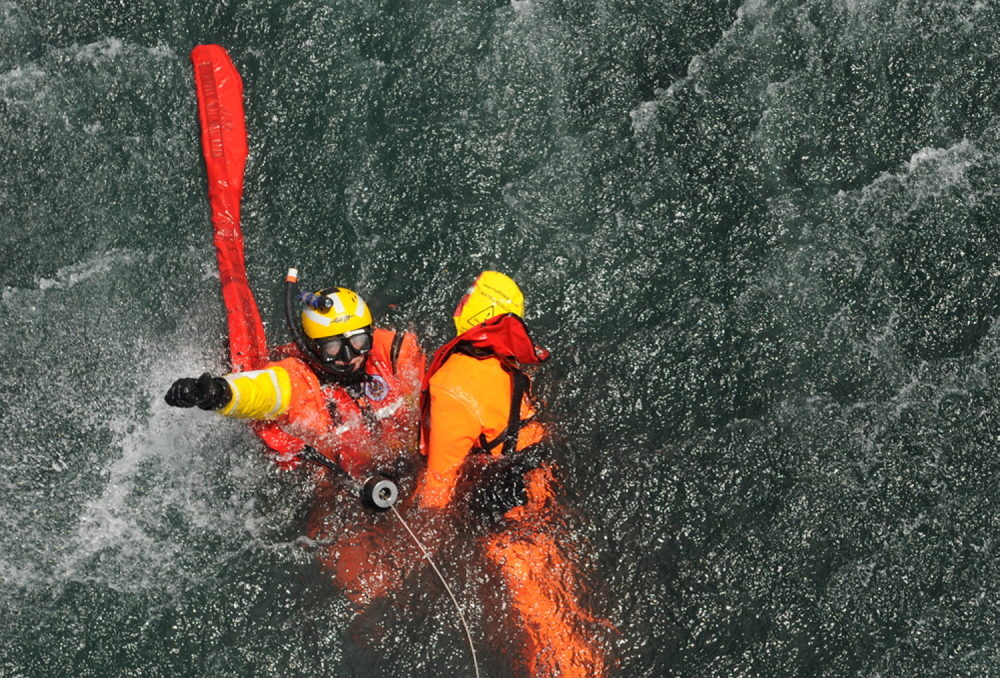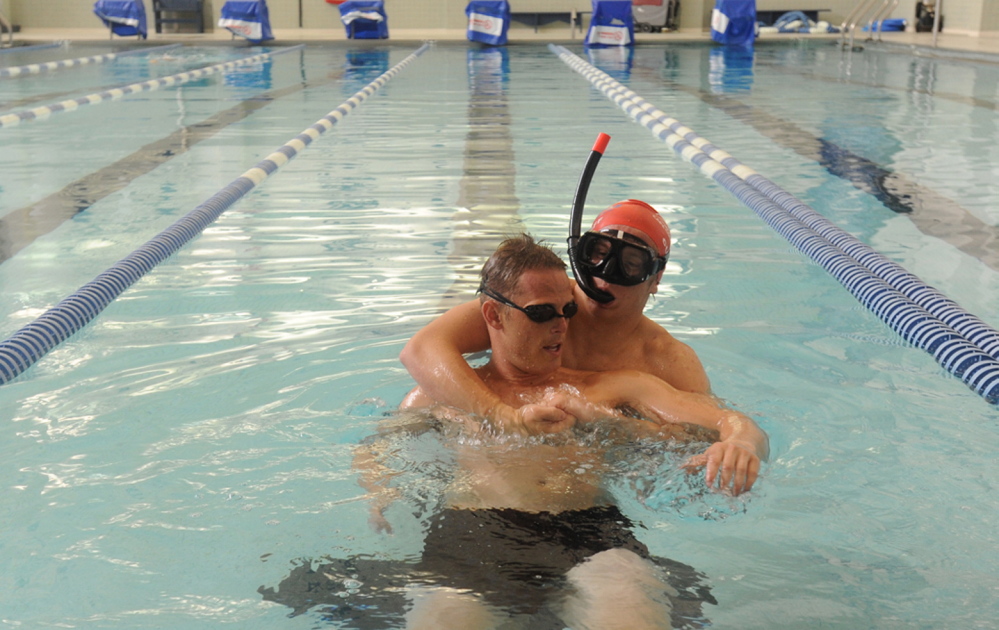BOURNE, Mass. — Brian Cundiff, a high school swimmer and lifeguard, wanted to see what it would be like to take his water skills to the next level.
So on a humid June day, the 18-year-old Sandwich High School graduate took to the pool at Massachusetts Maritime Academy in Buzzards Bay with several aviation survival technicians, better known as rescue swimmers, from Coast Guard Air Station Cape Cod.
Evan Staph, a rescue swimmer, showed Cundiff what it would be like to handle a victim who might be uncooperative after spending a prolonged period in the water – spoiler alert, they’re not always happy to see rescuers and have a tendency to initially fight them off.
He showed Cundiff what it’s like to go from a hypoxic state to a full-out sprint. And then he demonstrated a workout that includes multiple laps in the pool with scissor-kicks and arm push-ups on the pool deck mixed in.
“They showed me some stuff today that I’m not comfortable with and that’s what I’ll be working on,” said Cundiff, who remains convinced he wants to enlist in the U.S. Coast Guard with a track toward becoming a rescue swimmer. “It showed me what a different set of skills I’d need.”
‘MORE ABOUT POWER’
Cundiff, the son of a swim instructor, knows the perfectly executed strokes it takes to win a competition. “That all goes out the window when you have to pull somebody across the water,” Cundiff said. “Now it is more about power than technique.”
In the 2006 Hollywood movie, “The Guardian,” Kevin Costner and Ashton Kutcher gave a window into discipline it takes to be a rescue swimmer. The film also illustrated that drama that comes with a willingness to dive in and help someone tossed from the side of a boat, flailing in choppy surf, while a storm rages.
Over the past year, the Times observed several training exercises at Massachusetts Maritime Academy, at the air station and out on the ocean to provide some insight into the swimmers who are ready at a moment’s notice from Maine to New Jersey.
“They are amazing individuals and the level of professionalism and dedication they display is unmatched,” said Paul Brooks, the engineering officer who oversees the 12 rescue swimmers at Air Station Cape Cod. “What amazes me about rescue swimmers is that in order to do that mission you have to have a very strong, Type A, competitive attitude and they do . but when you ask them what they do, they’re probably the most humble people you’ll ever want to meet.”
Every training exercise, every maneuver is done with one goal in mind – to let muscle memory take over.
“So that in the event that the worst happens and conditions are the worst they can be, it’s an automatic reflex to perform the techniques the same way that we practiced to ensure that we get both the survivor and ourselves back safely,” said Chad Small, a petty officer stationed on Cape Cod.
That’s on top of the extensive training these swimmers already received at boot camp and in the pools with wave simulators and lightning bolts at Elizabeth City, North Carolina, followed by training as emergency medical technicians. It can take two years or more for a rescue swimmer to get into action at a base like Cape Cod.
‘VERY TRYING, VERY HUMBLING’
When Tye Conklin, who’s been a rescue swimmer for 16 years, saw the orange-and-white helicopters going up and down the coast of the Jersey Shore as a kid, he knew someday he wanted to be on one of those birds ready to spring into action.
“I was pretty lucky that I was the kid who knew what he wanted to do when he grew up and I still get to do it,” Conklin said.
Conklin is doing it these days in Kodiak, Alaska. It’s pretty common for a rescue swimmer to be moved around, part of the nomadic way of life for all members of the Coast Guard.
Just about the time Conklin was moving on, Staph, a rescue swimmer for six years, was moving in from Georgia.
“It’s been a pretty big experience coming from someplace that was a lot more calm and sleepy to a place where there are big rescues like here on Cape Cod,” Staph said.
Staph got to put his skills to the test in February when he was part of a crew that rescued a father and son 190 miles off the Cape coast during one of the winter blizzards. The pair was attempting to sail from Rhode Island to Australia.
“I never swam in such big waves, violent waves,” Staph recalled. “It was still the hardest case I’ve ever had.”
During the rescue, Staph was shocked by a static charge in the rescue basket and momentarily knocked out. He managed to hang on, come to and complete his portion of the rescue.
“It was very trying, very humbling,” he said.
Being a rescue swimmer isn’t all about being the strongest, which is the message Staph tried to get across to Cundiff.
“It’s more mental than it is physical. A lot of people are in great shape,” Staph said. “Quitting is not an option, ever. That’s not something you can train into someone.”
‘ANYTHING CAN HAPPEN’
Other swimmers have similar tales of rescues and almost all of them talk about the tremendous number of people and amount of resources it takes to perform a rescue – from the crew on the aircraft to the support back at the base and at the district level.
“It’s the famous job. It’s the one that will get you on the front page of the paper, but it’s a very small portion of the (overall mission),” Conklin said.
During a visit to Air Station Cape Cod, the alarm sounded for the crew on duty to do a medical evacuation from a ship 150 miles off the coast of Chatham.
“We’re not the duty crew, but we want to be the duty crew,” said Zephyr Mays, a rescue swimmer turned pilot who has also moved on to Kodiak, as he and Conklin described what goes into a rescue swimmer’s preparation – from the life vest and harness, to the pocket knife, strobe lights, waterproof radios and other items that might be needed for a rescue.
On the way to the scene, the crew devises a plan, but remains flexible to the situation it finds, Conklin said.
“There is no textbook of what can happen because anything can happen,” he said.
During Hurricane Katrina, Conklin was one of hundreds of Coast Guardsmen sent to Louisiana to perform search and rescues, plucking survivors off rooftops and from floodwaters. The outcomes are not always positive, but even in situations where a rescue turns into a recovery, the job is an important one.
“Bringing the person back to their family is much better than leaving someone out in a bad situation,” Conklin said. “You do the most you can for the people. There are times when you can’t save everybody. That’s a hard thing to realize.”
For Mike Linehan, a rescue swimmer for nine years, his latest tour has brought him back home. Linehan grew up in Lowell and went to college in Boston.
“People are having a bad day and you’re there to make sure they get home safe,” Linehan said, recalling a time when he helped rescue three fishermen on a New Year’s Eve. “Ultimately the goal is to get them from the situation they are in, back home to their families.”
During hurricanes, nor’easters, blizzards and other disasters, they stand ready to hop on a Jayhawk helicopter to come to the rescue if needed.
“That’s the reason you come to work every day,” Conklin said. “You don’t want bad things to happen, but you want to be there to help people.”
Send questions/comments to the editors.




Success. Please wait for the page to reload. If the page does not reload within 5 seconds, please refresh the page.
Enter your email and password to access comments.
Hi, to comment on stories you must . This profile is in addition to your subscription and website login.
Already have a commenting profile? .
Invalid username/password.
Please check your email to confirm and complete your registration.
Only subscribers are eligible to post comments. Please subscribe or login first for digital access. Here’s why.
Use the form below to reset your password. When you've submitted your account email, we will send an email with a reset code.